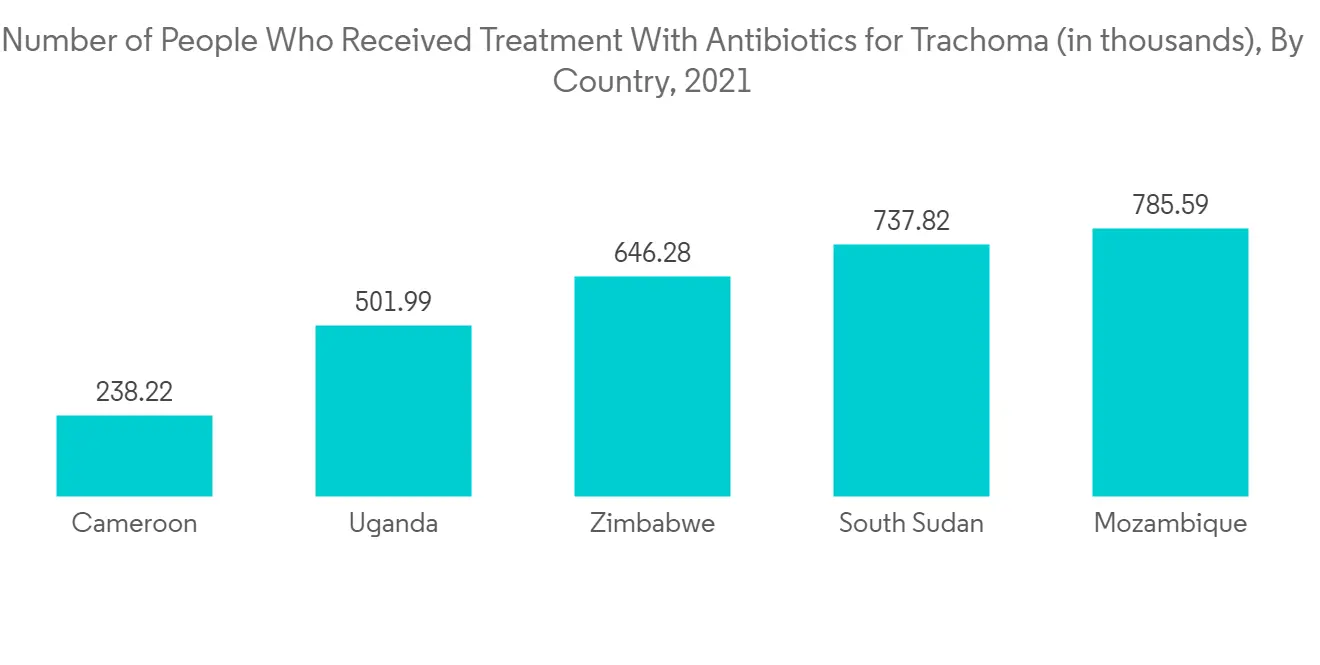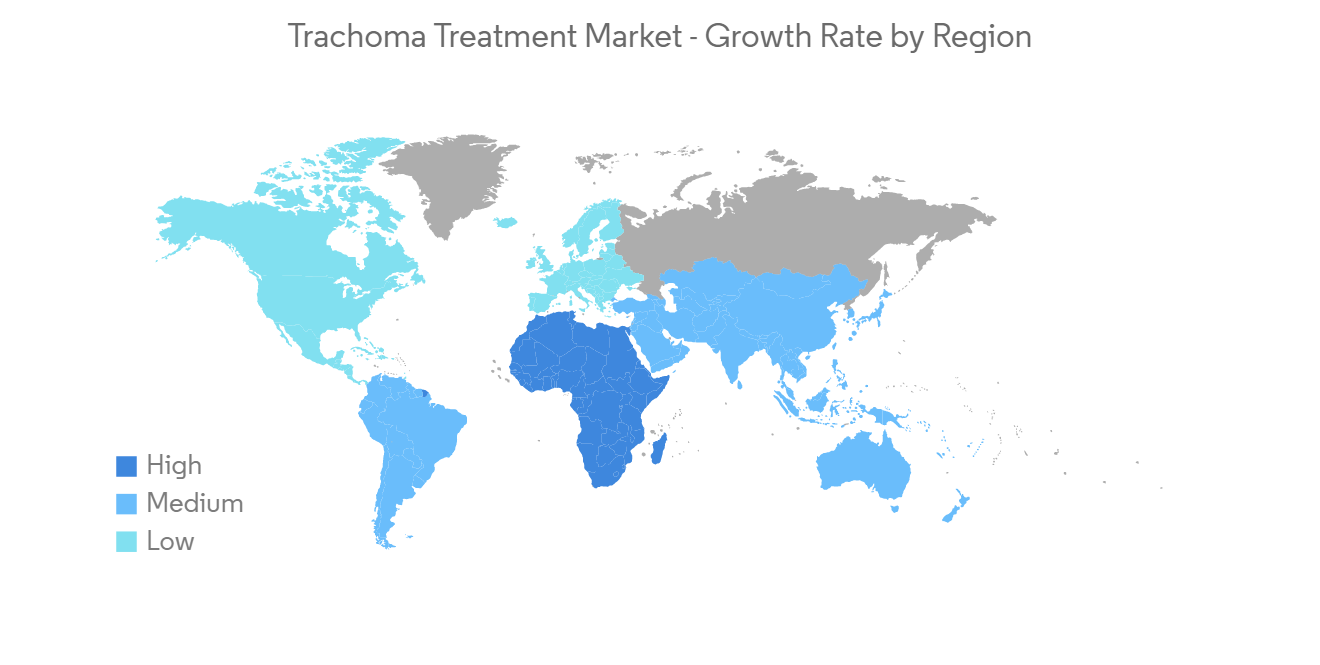PUBLISHER: Mordor Intelligence | PRODUCT CODE: 1273496

PUBLISHER: Mordor Intelligence | PRODUCT CODE: 1273496
Trachoma Treatment Market - Growth, Trends, and Forecasts (2023 - 2028)
During the time frame of the forecast, the trachoma treatment market is expected to grow at a CAGR of 5.5%.
The COVID-19 pandemic messed up not only the research and development of treatments and medicines for diseases other than COVID-19, but also the global supply chain for pharmaceuticals, which in turn affected the market for trachoma.For example, an article published in January 2021 by Tropical Medicine & Hygiene said that the coronavirus disease (COVID-19) pandemic messed up community-based efforts to control trachoma.Thus, the pandemic had a significant impact on the market initially. Currently, as the COVID-19 pandemic has subsided, the studied market is expected to have stagnant growth during the forecast period of the study.
The major factors driving the growth of the market include the increasing incidence and prevalence of trachoma and favorable government initiatives.
The rising prevalence of trachoma is a major factor driving the market's growth. For instance, according to the data updated by the CDC in June 2022, it is estimated that globally, almost 1.9 million people have vision loss because of trachoma every year, and it causes 1.4% of all blindness worldwide every year. The source also stated that an estimated 136 million people lived in trachoma-endemic areas around the world in 2021 and were at risk of trachoma blindness. Thus, the high prevalence of trachoma around the world is the major factor driving the market's growth.
Also, more efforts by governments around the world are likely to make people more likely to use trachoma drugs.For instance, according to the data updated by the Commonwealth of Australia in June 2021, trachoma is said to be still occurring in some aboriginal and Torres Strait Islander communities in Australia. The Australian government works with the affected states and territories to identify, treat, and prevent this condition, and they also report to the WHO's program to eradicate trachoma across the world.
Also, the Ministry of Health of the Republic of Kenya said in October 2021 that the fight against trachoma, a disease that can cause blindness, got a boost when Kenya and Uganda started a cross-border mass drug administration exercise.The exercise was launched at Alaka's primary school in the Amudat district of Uganda and sought to synchronize drug administration among the residents of west Pokot and Turkana counties with those of neighboring Uganda in an effort to fully eradicate the disease, which is caused by bacteria that attack the inner surfaces of the eyelids.
Thus, the aforementioned factors, such as the rising prevalence of trachoma and the increasing initiatives by the government, are expected to boost market growth. However, the lack of awareness about trachoma and the side effects associated with the drugs is expected to hinder market growth.
Trachoma Treatment Market Trends
Oral Route of Administration is Expected to Hold a Significant Share of the Market Over the Forecast Period
The oral route of administration is expected to have a big share of the market because it is the easiest and most popular way to give a drug. It is also easy to make, cheap, flexible in how dosage forms can be made and has the fewest sterility restrictions. As antibiotics are the first line of therapy for the targeted patient pool, this may boost the revenue growth of the segment. Most of the time, antibiotics, like azithromycin and tetracycline, are used to treat trachoma. Rising government programs to treat trachoma and the growing number of people who have it are the main things driving the segment growth.
According to information updated by the WHO in October 2022, Chlamydia trachomatis bacteria cause trachoma, which is an eye disease.It is considered a public health problem in 42 countries around the world, and it is responsible for the blindness or visual impairment of about 1.9 million people. Blindness from trachoma is irreversible and cannot be cured. The source also stated that, based on June 2022 data, 125 million people live in trachoma-endemic areas and are at risk of trachoma blindness. Thus, the high prevalence of trachoma is expected to boost segment growth.
Also, in June 2022, the Ministry of Public Health and Social Assistance of Guatemala (MPHSA) and the Pan American Health Organization (PAHO) worked together on a health campaign to operate on people with trachoma in Solola. This was done to stop the disease from getting worse and causing people to lose their sight. Thus, the increasing initiatives by governments are also expected to boost segment growth.
Thus, the things we've talked about so far, like the growing number of people with trachoma and the growing number of government programs, are likely to boost segment growth during the study's forecast period.

Middle East and Africa is Expected to Hold a Significant Share in the Market and Expected to do the Same Over the Forecast Period
The Middle East and Africa are expected to hold a significant market share in the trachoma treatment market, as it is the most affected region with trachoma cases. The high prevalence of trachoma in the region and the rising initiatives by governments for the treatment of trachoma is expected to boost the market growth in the region.
According to a report published by WHO in November 2022, there are approximately 105,286,061 people living in the areas that warrant treatment with antibiotics, facial cleanliness, and environmental improvement for the elimination of trachoma as a public health problem in Africa in 2022. Thus, the high risk of trachoma in Africa and the increasing treatment of trachoma with antibiotics in the region are expected to boost the market growth in the region.
Furthermore, according to the data published by Orbis International in 2022, with funding from the Qatar Fund for Development, and the Qatar Creating Vision initiative, implemented by Orbis, they have launched in Ethiopia with a team of volunteers who will be supporting the vital sight-saving activity. The source also stated that until September 2023, Orbis will train over 600 volunteers, some of whom are part of Ethiopia's Health Development Army, and they will be given the skills needed to screen every adult in their community and identify anyone with trachoma. Thus, the rising initiatives by various organizations are also expected to boost the market growth.
Hence, the aforementioned factors such as the rising prevalence of trachoma and the increasing government initiatives are expected to boost the market growth in the region during the forecast period of the study.

Trachoma Treatment Industry Overview
The trachoma treatment market studied is moderately competitive, and there are several international as well as local companies. Some of the companies that are currently dominating the market are Apotex, Pfizer Inc., Teva Pharmaceutical Industries Ltd, Sandoz Inc. (Novartis AG), Arbor Pharmaceuticals Inc. (Azurity Pharmaceuticals, Inc.), Fresenius Kabi AG, Merck & Co. Inc., and Allergan (AbbVie Inc.), among others.
Additional Benefits:
- The market estimate (ME) sheet in Excel format
- 3 months of analyst support
TABLE OF CONTENTS
1 INTRODUCTION
- 1.1 Study Assumptions and Market Definition
- 1.2 Scope of the Study
2 RESEARCH METHODOLOGY
3 EXECUTIVE SUMMARY
4 MARKET DYNAMICS
- 4.1 Market Overview
- 4.2 Market Drivers
- 4.2.1 Increasing Incidence and Prevalence of Trachoma
- 4.2.2 Favourable Government Initiative
- 4.3 Market Restraints
- 4.3.1 Lack of Awareness About Trachoma
- 4.3.2 Side Effects Associated with the Drugs
- 4.4 Porter's Five Forces Analysis
- 4.4.1 Threat of New Entrants
- 4.4.2 Bargaining Power of Buyers/Consumers
- 4.4.3 Bargaining Power of Suppliers
- 4.4.4 Threat of Substitute Products
- 4.4.5 Intensity of Competitive Rivalry
5 MARKET SEGMENTATION (Market Size by Value - in USD Millions)
- 5.1 By Route of Administration
- 5.1.1 Oral
- 5.1.2 Topical
- 5.2 By Drug Class
- 5.2.1 Macrolides
- 5.2.2 Tetracycline
- 5.2.3 Ophthalmic Anti-infective
- 5.2.4 Sulfonamides
- 5.3 Geography
- 5.3.1 North America
- 5.3.1.1 United States
- 5.3.1.2 Canada
- 5.3.1.3 Mexico
- 5.3.2 Europe
- 5.3.2.1 Germany
- 5.3.2.2 United Kingdom
- 5.3.2.3 France
- 5.3.2.4 Italy
- 5.3.2.5 Spain
- 5.3.2.6 Rest of Europe
- 5.3.3 Asia-Pacific
- 5.3.3.1 China
- 5.3.3.2 Japan
- 5.3.3.3 India
- 5.3.3.4 Australia
- 5.3.3.5 South Korea
- 5.3.3.6 Rest of Asia-Pacific
- 5.3.4 Middle East and Africa
- 5.3.4.1 GCC
- 5.3.4.2 South Africa
- 5.3.4.3 Rest of Middle East and Africa
- 5.3.5 South America
- 5.3.5.1 Brazil
- 5.3.5.2 Argentina
- 5.3.5.3 Rest of South America
- 5.3.1 North America
6 COMPETITIVE LANDSCAPE
- 6.1 Company Profiles
- 6.1.1 Allergan (AbbVie Inc.)
- 6.1.2 Apotex
- 6.1.3 Pfizer Inc.
- 6.1.4 Teva Pharmaceutical Industries Ltd
- 6.1.5 Sandoz Inc. (Novartis AG)
- 6.1.6 Arbor Pharmaceuticals Inc. (Azurity Pharmaceuticals, Inc.)
- 6.1.7 Fresenius Kabi AG
- 6.1.8 Merck & Co. Inc.
7 MARKET OPPORTUNITIES AND FUTURE TRENDS




